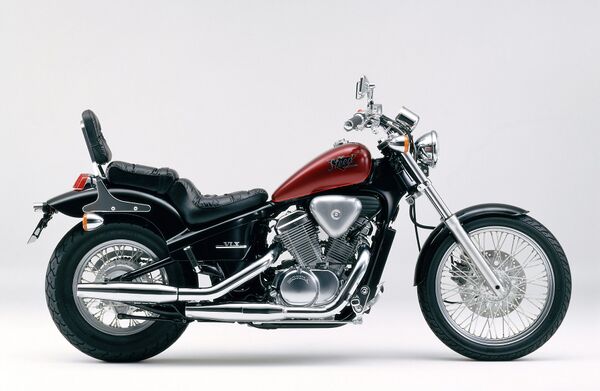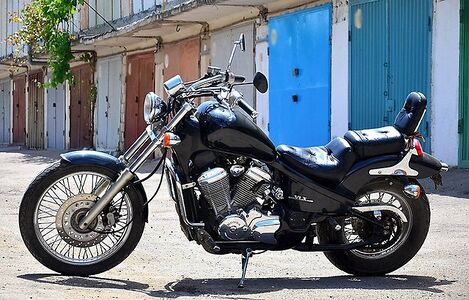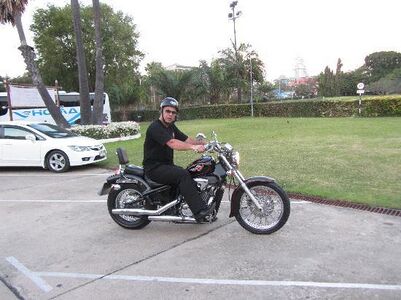Difference between revisions of "Honda Steed 600"
m |
m (→Photos) |
||
| Line 26: | Line 26: | ||
== Photos == | == Photos == | ||
| − | + | <gallery mode="packed" heights=200px> | |
| − | + | File:275271-tm1495104346.jpg| | |
| − | + | File:1426691896112 bulletin.jpg| | |
| − | + | File:Honda-steed-600-cc.jpg| | |
| − | + | </gallery> | |
| − | |||
{{Ads_feed}} | {{Ads_feed}} | ||
{{Ads_post}} | {{Ads_post}} | ||
Latest revision as of 12:02, 27 June 2023
The Honda Steed 600 cruiser was first introduced in 1988 and was produced up to and including 1995. The model was produced in parallel with Honda Steed 400 and was targeted only at the domestic Japanese market. Outside of Japan, the motorcycle was sold under the names Honda Shadow 600, Honda VT600C and others. The Japanese Steed 600 was designated the NV600. In this review, we will only consider the Steed 600 for the Japanese market, while the VT600 Shadow model will be covered in a separate article.
Lineup:
Main competitors:
The Honda Steed 600, unlike Steed 400, could not be used by novice drivers as it required a higher category driver's license. That is why the model was produced in significantly smaller quantities and had only one standard modification (called the VLX).
The Steed 600 was produced until 1995 inclusive, without actually being seriously updated, after which it left the market. The success of the Steed 400/600 models in Japan was driven by the American-style motorcycle boom in the early 1990s, which in fact made the Steed series a bestseller, with 80,000 units produced and sold throughout its history.
Models Steed 600 and Steed 400 had a common base and differed only in the engine (increased volume, 36 hp and 44 Nm instead of 31 hp and 33 Nm) and carburetors (VDF1 instead of VDD0). An important feature of the Steed 600 is that it was only produced with a 4-speed gearbox. Both models are popular on the Russian market, but the 400 cc version is much larger. This is mainly due to the price and widespread availability of the Steed 400 in Japan. The differences between the Steed 400 and the Steed 600 are so minimal that often dishonest sellers sell the 400cc version under the Steed 600 name.
Photos
Specifications
Specifications Honda Steed 600:
| Model | Honda Steed 600 |
|---|---|
| Motorcycle type | cruiser |
| Release year | 1988-1995 |
| Frame | steel tubular |
| Engine type | 2-cylinder, 4-stroke, V-shaped |
| Working volume | 583 cm³ |
| Bore / stroke | 75.0 x 66.0 mm |
| Compression ratio | 9.2: 1 |
| Cooling | liquid |
| Number of valves per cylinder | SOHC, 3 valves per cylinder |
| Fuel supply system | carburetor, 2x Keihin 34 mm (VDF1) |
| Ignition type | transistor |
| Maximum power | 36.0 h.p. (26.5 kW) at 6500 rpm |
| Maximum torque | 44.0 Nm (4.5 kg * m) at 3000 rpm |
| Gearbox | 4-stage |
| Drive type | chain |
| Front tire size | 100 / 90-19 (57S) |
| Rear tire size | 170 / 80-15 M / C (77S) |
| Front brakes | 1 disc, 296 mm, 2-piston caliper |
| Rear brakes | drum |
| Front suspension | telescopic fork |
| Rear suspension | linkage with monoshock |
| Motorcycle length | 2310 mm |
| Motorcycle width | 760 mm |
| Motorcycle height | 1130 mm |
| Wheelbase | 1600 mm |
| Saddle height | 680 mm |
| Minimum ground clearance | 140 mm |
| Acceleration to 100 km / h | 7.9 sec |
| Maximum speed | 150 km / h |
| Fuel tank capacity | 9.0 L - Steed 600 (1988-1992)
11.0 L - Steed 600 (1993-1995) |
| Motorcycle weight (dry) | 196 kg - Steed 600 (1988-1989)
199 kg - Steed 600 (1990-1992) 201 kg - Steed 600 (1993) 204 kg - Steed 600 (1994-1995) |
| Motorcycle weight (curb) | 208 kg - Steed 600 (1988-1989)
211 kg - Steed 600 (1990-1992) 214 kg - Steed 600 (1993) 217 kg - Steed 600 (1994-1995) |
Fuel consumption
The officially declared fuel consumption of the Honda Steed 600 is 2.62 liters per 100 kilometers (Japanese method of measurement: constant speed 60 km / h, driver + passenger).
Documentation



